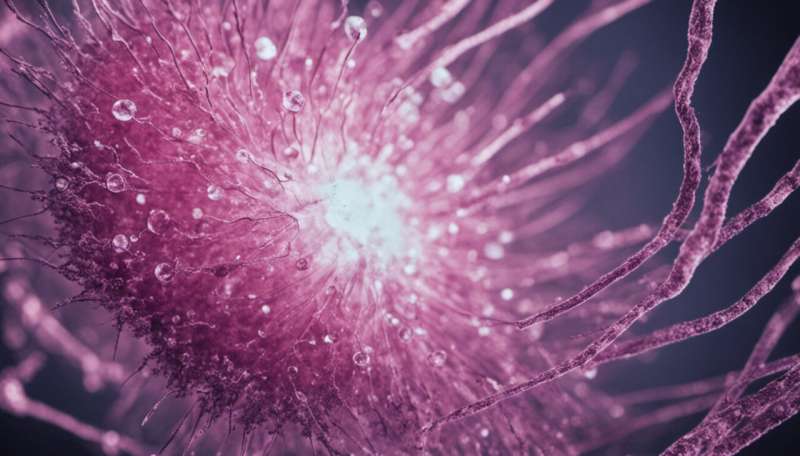What is normal vaginal discharge and what's not?

V-juice, vovey-goo, vu-dew… there are many ways to describe the natural fluid that comes out of the vagina. It varies in consistency, texture, smell, taste and volume in the same woman from day to day, week to week, month to month and beyond.
During puberty, several hormones act together to grow the vagina, uterus, fallopian tubes, ovaries and external genitals. The hormones oestrogen and progesterone contribute most to the evolution of the glorious ecosystem that is the adult vagina.
The adult vagina is a muscular, elastic tube extending from the cervix (lower part of the uterus) to its opening between the urethra (where urine leaves the bladder) and anus.
What lies within the vaginal walls has inspired folklore over centuries: penis-devouring teeth, serpents and dragons. This has essentially served to demonise women's sexuality.
Rather than a menagerie of deadly creatures, the inner lining of the vagina is made up of a type of skin cell which does not contain keratin. Keratin is the tough protein found in external, exposed skin cells (as well as hair and nails) which helps skin form a protective barrier. The vaginal lining is therefore much softer, and is supported by a network of blood vessels which "leak" clear watery fluid into the vaginal space (called a transudate).
The cervix protrudes into the top of the vagina, and is made up of unique cell "zones" which are highly responsive to hormones and produce mucus.
During ovulation, cervical mucus has a thin, runny, egg-white-like consistency that is clear. At other times of the menstrual cycle it tends to be thick and opaque.
Adult vaginas contain a range of active glands – mini-organs that make sweat or oils. They also contain lactobacilli – microorganisms that live in the healthy adult vagina and maintain an acidic pH (4 – 4.5) which protects the vagina from infection.
Natural vaginal discharge is a rich cocktail of these components: transudate, mucus, sweat, oils, lactobacilli, menstrual flow and cells from the vaginal lining.
From a woman's first periods until menopause, menstrual hormones drive her vaginal discharge. On average, she makes one to four millilitres of vaginal fluid a day. This increases with higher oestrogen levels, such as during pregnancy and ovulation.
Sexual arousal leads to sudden bursts (or trickles) of fluid, due to increased blood flow in the pelvis and thus more vaginal transudate.

The dramatic decrease in oestrogen levels after menopause leads to changes in the vagina's cell lining, reduction in lactobacilli numbers, and a much drier vagina.
When is vaginal discharge problematic?
For some women, excessive amounts of discharge can cause discomfort. Some women have "cervical ectopy", which can increase discharge. This is where the zone of mucus-producing cells of the cervix faces outward into the top of the vagina, instead of being within the cervical canal.
Altering the pH of the vagina can lead to the overgrowth of organisms such as candida, a yeast, commonly called thrush. The typical discharge caused by thrush is white, cottage cheese-like and accompanied by an itch and sometimes redness, swelling and pain during urination.
Bacterial vaginosis is another overgrowth condition, of a type of bacteria. BV might not cause noticeable extra discharge but if it does, it is often fishy-smelling and frothy.
Sexually transmitted infections (STIs) are sometimes the cause of vaginal discharge, the most notable being chlamydia, gonorrhoea or trichomonas. All three STIs can be asymptomatic in women (especially chlamydia), but if a discharge is present, it tends to be purulent – meaning pus-producing – in chlamydia and gonorrhoea infections, and yellow, frothy and smelly in trichomonas infections.
Skin conditions of the vulva and vagina can also affect vaginal discharge. Irritation from perfumes, deodorants, soaps and over-cleaning can lead to chronic dermatitis, while douching and spermicides can irritate the vaginal lining or change the delicate ecological balance.
Some women also have allergies to latex (the ingredient in most condoms) or other products that might enter the vagina. In all of these skin-related problems, discharge is not necessarily the main symptom, and itch, pain, redness or swelling might be more prominent.
Tampons accidentally left inside the vagina for days (and sometimes weeks!) often cause a smelly discharge.
If you're concerned about your vaginal discharge, visit your GP or your local sexual health, women's health or family planning clinic. The doctor or nurse might enquire about your menstrual and pregnancy history, use of contraception and hormones, sexual history, medical history including skin conditions and use of topical products on the genital skin, the presence of other symptoms, and use of tampons or other objects inserted into the vagina.
Examining vaginal discharge under the microscope helps identify or rule out overgrowths and infections, and specific DNA or other tests can accurately pinpoint the common STIs.
This article was originally published on The Conversation. Read the original article.
![]()

















